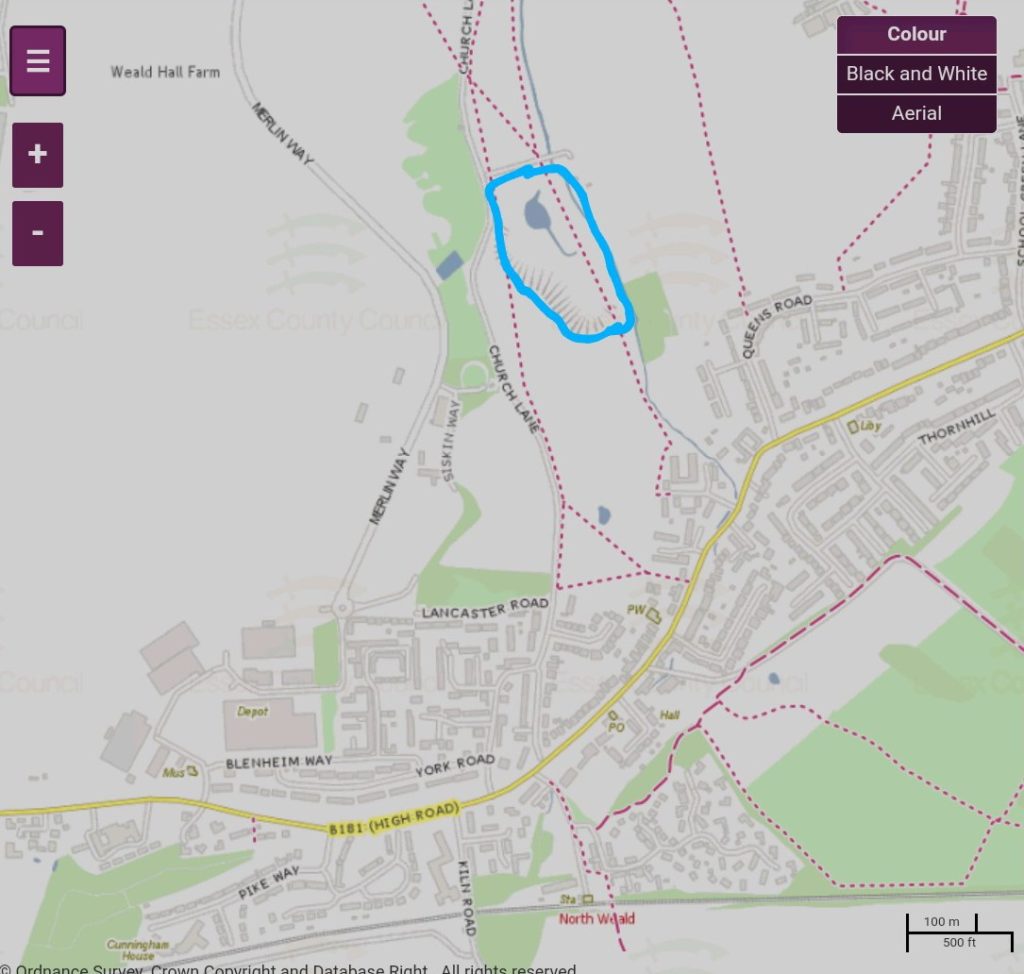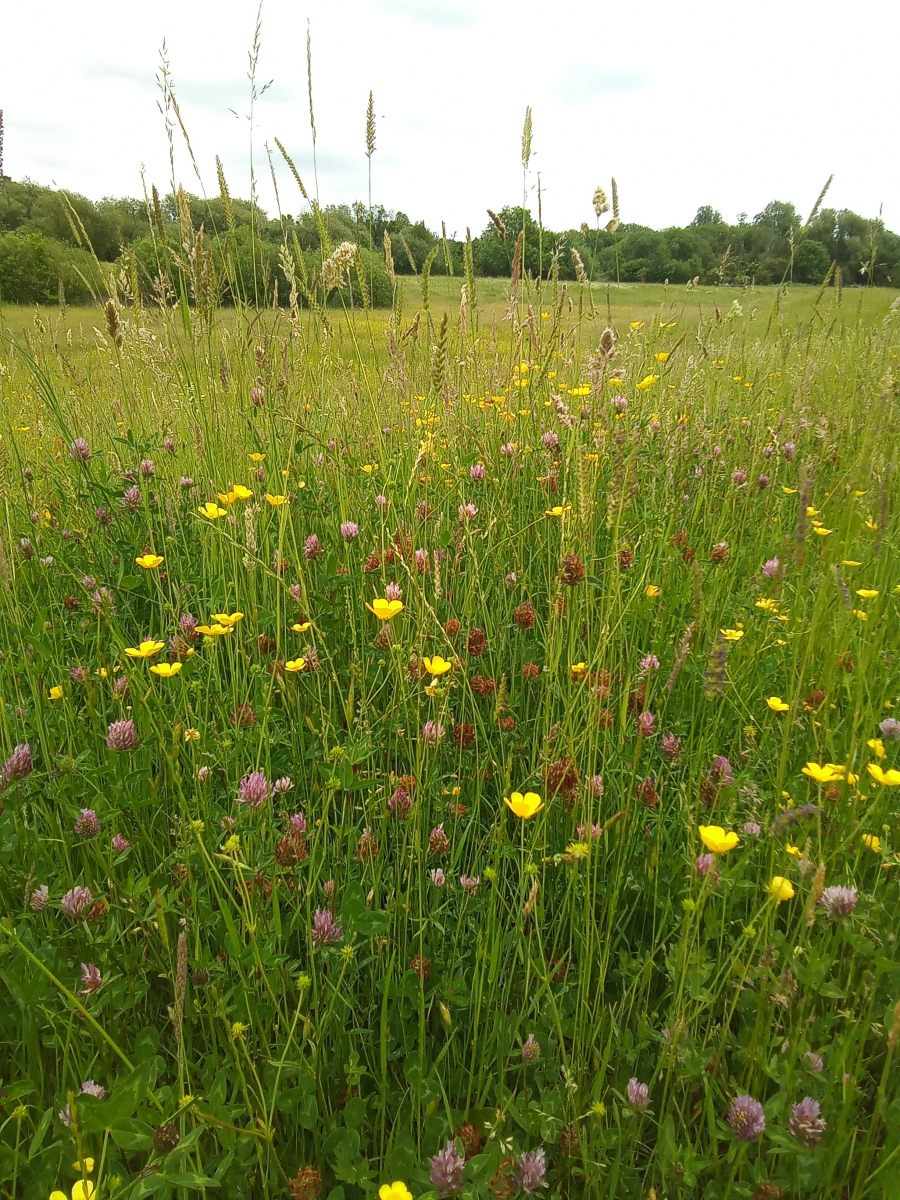Church Lane Flood Meadow Nature Reserve
Situated to the East of North Weald airfield and managed by Epping Forest Countrycare, Church Lane flood meadow in North Weald is one of several flood meadows within the North Weald parish specifically created as flood alleviation schemes for nearby villages prone to flooding. Church Lane flood meadow, since it’s creation in the late 1980’s has been an incredible success story. What started out as a piece of former arable farmland with limited productivity is now one of the most ecologically diverse habitats in the area. The site lies within the catchments of the river Roding and North Weald Brook, a minor tributary of Cripsey Brook.

Ordnance survey map credit to Essex County Council
After severe flood damage to the village of North Weald Basset in August 1987 a major project was undertaken to store flood water from North Weald Brook in the event of any future extreme weather events. Part of this project involved the excavation of a large flood bowl to create a stream fed wildlife pond capable of holding back 35 million litres of flood water upstream, thus acting as an effective flood defense system for vulnerable properties further downstream.
This work was completed in 1989. As well as using commercial meadow seed mixes, the technique of green hay strewning was put to good use here with amazing results. Strewning involves harvesting ‘donor hay’ from existing SSSI meadows elsewhere and transporting it to a recipient site, where it is then spread and left for the seed to disperse on to the new site. This is a well proven method of increasing biodiversity which at Church Lane flood meadows has been a massive success. In this case donor hay was brought in from the Roding Valley wet meadows in Redbridge and Hunsdon Mead wet meadows in Roydon near the river Stort. The results have been nothing short of incredible.
Not only did the strewning methods result in Church Lane flood meadows becoming host to all the common meadow wildflowers you would expect to see at the two donor meadows but after a few short decades it also laid down the foundations to provide the optimum conditions for some incredibly rare plants which grow in few other locations in Essex. Church Lane flood meadow is now one of the few places in the county you will find Common Spotted Orchids and Bee Orchids growing together. The site now boasts around 200 species of grasses, flowering plants and trees. The key dominant flowering species in the meadow include Devils Bit Scabious, Ragged Robin, Bugle and Marsh Cinquefoil.
The site is predominantly a wetland meadow, but incorporates a range of other habitats to increase overall biodiversity including wooded areas, wet meadow and open grassland. A number of marginal and aquatic plants have colonised the more marshy areas of meadow which stay wet year round. Over 2,500 native trees have been planted around the site which after 30 years have begun to form areas of secondary woodland and extensive new hedgerows have been created to further compliment the old hedgerows, using laying methods to bridge gaps in hedges to screen the site from the airfield and provide nesting sites for smaller birds.
As the flood meadow has established, it has shown a very encouraging diversity in invertebrates attracted to its rich habitats. Surveys have identified over 16 species of butterfly and moth at the site and year on year this number increases. There have also been 10 species of dragonfly observed at the site. In addition to the wealth of invertebrates found here, around 60 different bird species have been recorded at Church Lane flood meadow including Kingfishers and 2 different species of Snipe. Sandpiper and Hobby have also been recorded. There are very healthy populations of frogs, toads and smooth newts. Six species of mammal including protected water voles and Weasels have been recorded at Church Lane flood meadow.
Two public footpaths cross the site. Footpath number 41 runs alongside North Weald Brook along the Eastern edge of the site, and footpath number 43 runs parallel with the Western boundary. Both of these footpaths connect North Weald village with St Andrews Church. Access to the site is on foot and parking is limited either to the village at the South of the site before joining a footpath, or there is a small car park on Vicarage Lane West to the North of the site opposite the village hall in front of St Andrews Church.
Although the main usage comes from dog walking, Church Lane flood meadow is used for a number of conservation activities and education purposes. There is a strong sense of ownership by the local community, the village preservation society take a keen interest and have been actively involved in looking after the reserve. In previous years they have provided volunteer wardens from their own staff to keep an eye on the meadow. Much of the conservation work is carried out by local volunteers who have always strongly supported Countrycare staff in preserving the meadow.
After just over 30 years since it’s creation, the success of Church Lane flood meadow has shown how easily and how quickly an area of previously sterile arable farmland can be transformed into a wildlife haven. It has also shown that in the case of much of the resident wildlife and flora, it only takes a few relatively small changes to create an incredibly diverse habitat capable of supporting an abundance of life forms, including some of the most endangered plants found in the whole of Essex. Perhaps a lesson here is that sometimes just standing back patiently and doing nothing can be the greatest contribution we can make for the plant and animal life waiting for the right conditions to arrive. The rest it seems, they can do themselves.
Church lane Flood meadow Nature reserve North weald Wild orchid
















